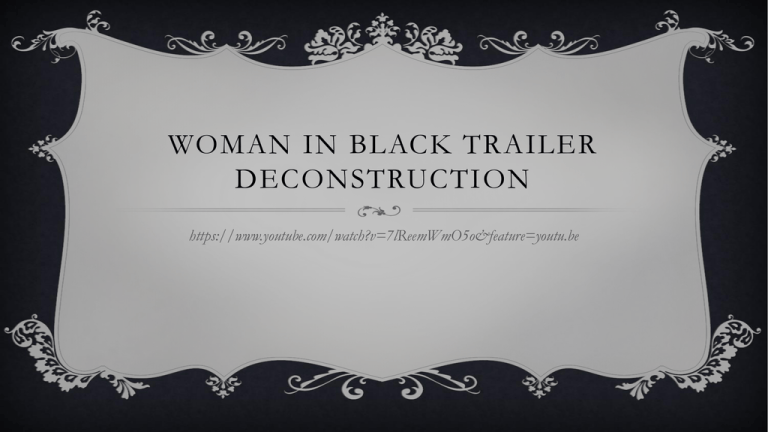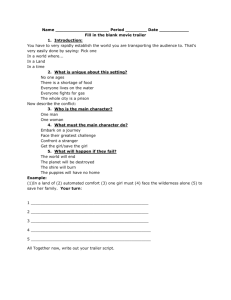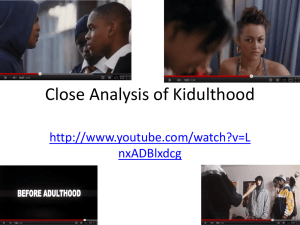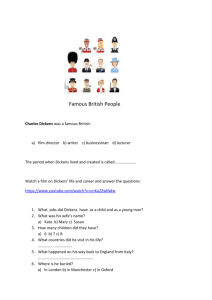Woman In black - WordPress.com
advertisement

WOMAN IN BLACK TRAILER DECONSTRUCTION https://www.youtube.com/watch?v=7lReemWmO5o&feature=youtu.be CAMERA SHOTS The opening uses several close ups of toys with each of them fitting to the rule of thirds. The eyes of these toys each fit the rule of thirds grid which makes an audience eyes go straight to this point when they first see them. This allows an audience to gain a more personal connection but also makes them feel uncomfortable. Additionally, using close ups to display these toys creates a sense of unease for a consumer as there is nothing else for them to look at. The choice of using toys creates a feeling of innocence and purity as they are often associated with childhood however the appearance of the toys is quite unexpected as they are displayed in an opposite way to what an audience expects and as a result creates a sinister atmosphere. Another use of close-ups is to show the reactions of other characters to the Woman In Black. This can help create a sense of fear in the audience as they can anticipate over what is happening in the scene. CAMERA SHOTS CONTINUED The next big use of camera shots are establishing shots and long shots. These types of shots are common to a trailer as they help the audience to introduce the premise to the film. For example, these shots inform the audience of what the time period (Victorian) is for the film and where the majority of the action is taking place (Eel Marsh House). Upon further analysis, the fact that the house is old or abandoned can support the idea that the house carries a certain memory or secret which makes it become more than just a house- but a place to be feared. Additionally, the use of long shots can foreshadow the idea of isolation and the typical ‘no-one can hear you scream’ factor that are used in the horror genre. Another way to interpret the long shots is that they help to show the protagonist as weak or as a victim as some are filmed from a high-angle. This is unusual for a trailer to make their protagonist weak as they are usually meant to be the hero and therefore, presented as a strong character. This agreement could be reversed as the protagonist could be viewed as strong for entering the house and confronting the Woman in Black . EDITING The use of editing fluctuates throughout the trailer, this is to keep audiences involved in the text. Towards the end of the trailer, the editing is quick, using fast cuts to build tension. As these cuts are quick, it makes the reader question what it is that they have just seen. This encourages an audience to go and watch the film whilst also creating a sense of fear. For example, multiple scenes are put together with a black out in between, this makes the trailer continuous and flows well with the narrative. The black-outs reflect the name of the film - the Woman in Black. The use of parallel editing has been incorporated into the trailer as different things are happening in house at the same time. For example, the toys are moving in one room, the children’s tea party and the protagonist travelling to the house. This shows that eventually all of these elements will meet so foreshadows that something will happen. SOUND The trailer for Woman in Black uses the tune of a children’s music box throughout. This type of music would normally be associated with children and this connotes the idea of innocence and purity. This music is played in time with the movements of the toys. For example, on every chime, the scene will cut to the next. This happens throughout the trailer therefore it i a constant reminder for the audience that children will play a significant role in the film. The children’s tune is very repetitive so perhaps foreshadows that the Woman in Black is undefeatable and her reign over Eel Marsh House will always remain. Alongside the sounds from the music box, there are also sounds from the weather. Such as, wind, lightning and rain are used as diegetic sounds. This instantly creates a dark and gloomy atmosphere. If these sounds were played alone, an audience are most likely to know that the atmosphere is quite negative. This is suitable for this style of film as the weather is a typical convention in setting the scene of a horror film. The use of silence at the beginning of the trailer can argue against Todorov’s narrative theory as it implies that there is no equilibrium to the film and that chaos runs throughout. NARRATIVE The trailer has a child voice-over narrating. This connotes the idea of innocence and purity through its nursery-rhyme feel. However, the topic she discusses is quite sinister when played along with images from the trailer. Likewise, the fact the the sentences rhyme shows how the cycle of the Woman in Black is always going to happen. This creates an uneasy atmosphere for an audience and highlights the horror genre. MISE EN SCENE The setting always appears quite dark and isolated. This creates a sense of fear as the town is abandoned, meaning that the main character is distant from society. The trailer shows bars that surround the house and bars around the houses in the village. This can connote the idea that the characters are trapped in a prison like environment. Similarly, the bars in front of the children highlight how they too are trapped by the Woman in Black. The forest is also used as a setting which is another typical convention of horror films. The trees surround the main character and this emphasises that he is trapped with the Woman in Black and cannot escape. MISE EN SCENE CONTINUED The use of colour grading in this trailer gives the idea that everything is dark and gloomy: all of these are typical conventions of the horror genre or to fit with themes in the film such as death and loneliness. This links in with the character’s costume. Within the trailer, costumes are often quite pale which could suggest how they are becoming distant/ghost-like which is relevant to the ghost story. The main character however, stands out as he is dressed all in black showing how he is an outsider or perhaps trying to relate to the woman in black. TEXT The text suits the style of the film: it has a formal lettering which fits the Victorian aspect of the film and the fact that it is written on a window plays with the idea of whether it is really there or not which again, links to the supernatural elements in the film. The text allows the target audience (teenagers) to promote their film by using their website and twitter account which is a type of synergy. Even though the trailer does not show a release date, by saying “Coming Soon” suggests that the film is something that audiences need to start looking for and leaves a sense of mystery. THEORISTS The most predominate theorist used in this trailer is Roland Barthes as the trailer creates an array of enigmas about the film. For example, who the Woman in Black is or why she is important is not revealed in the trailer. Similarly, from the trailer it is unclear why the main protagonist is in Eel Marsh House and there is no link or clue revealed between his and the Woman in Black’s relationship. Photos of a family are repeated throughout the trailer with their eyes scratched and again, this creates mystery as their history or significance to the film is unknown and why their picture has been vandalised is unclear. All of these factors help to contribute to enticing an audience to watch the film as they will have questions that need to be answered. AUDIENCES AND INSTITUTIONS The opening credits of the Woman in Black trailer reveals that Cross Creek Pictures produce the film and CBS and Momentum are responsible for the distribution. Cross Creek pictures are known for their production of horror films including Bone Shaker, Black Swan, and Clown. These films will help the audience prepare themselves on what they are going to see and allow them to make a judgement before watching the trailer. Financially, the film was a success with a box office of 128.5 million dollars. However, due to age rating issues, the film caused some uproar in the public eye.





